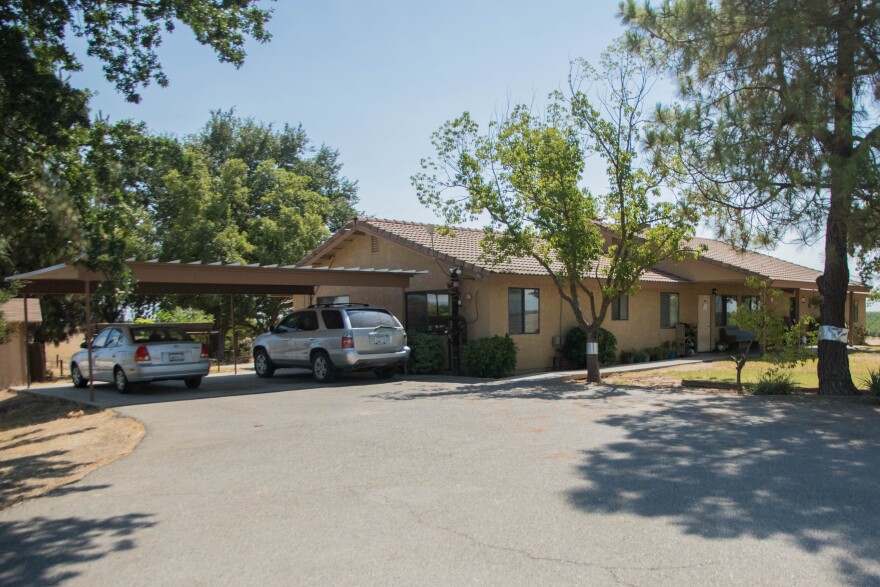Drive through the pomegranate and pistachio orchards between Highways 41 and 99 and you may stumble upon Valley Teen Ranch, a cluster of residential homes where juvenile offenders come to be rehabilitated.
Today, a few men are in their living room playing a basketball video game and making small talk with Connie Clendenan, the ranch’s CEO. “I'm for the Warriors, don't we have them?” asks Clendenan. “I'm from Oakland, so yeah,” one of the men laughs.
'So we have to cha-cha, as I call it, with the bureaucrats in the state and county and federal government." - Connie Clendenan, Valley Teen Ranch
In an ideal world, Clendenan would spend most of her time working directly with the 30 or so men who live here. “They need a lot of kindness, patience, grace, and a healthy relationship,” Clendenan says, "in order to be able to make some changes in their life.”

But instead, she spends a lot of time worrying about water. Since 2008, Valley Teen Ranch’s water system has been out of compliance with state code because of arsenic contamination. She and a staff member show me 14 huge water bottles stacked up against the wall—the kind you place on an office water dispenser. “So is this all the bottled water that we would use in a month for this house?” Clendenan asks. “No, that's for the week,” he says.
A school complex down the street also struggles with arsenic levels. Together, they have a plan: They’ll connect themselves to a water system in Madera Ranchos, a nearby unincorporated community with clean drinking water. This $6.6-million state funded project is the latest iteration of something Valley Teen Ranch has been working on for nearly a decade—and yet, it still hasn’t been approved by the state.
All the entities involved are seemingly on board. So what’s the holdup? Paperwork. Bureaucracy. The very same processes that are in place to ensure safe drinking water in the first place. “So we have to cha-cha, as I call it, with the bureaucrats in the state and county and federal government,” Clendenan says.
When Clendenan learned the ranch’s water was unsafe, she jumped on a plan: They would drill a new well that would hopefully tap into cleaner water. She hired a contractor, did all the necessary environmental assessments, and wrote a grant to the state water board to pay for the project. The process took years, and tens of thousands of dollars.
Then, a few years ago, everything changed. The Liberty High School complex about a mile away was struggling with arsenic as well. The state decided to change the plan and connect them both to the community of Madera Ranchos, in what’s called a water system consolidation. “I’m confident that if we were just to have pursued an independent solution with Valley Teen Ranch we would've already been there,” says Kassie Chauhan with the State Water Resources Control Board, “but we felt like it was worth the delay to pursue a better long term solution.”

According to Chauhan, consolidating water systems is typically a cheaper, more long-term alternative to drilling more wells and treating the water at each site individually.
Chauhan says administrative changes at the state and local level also meant the grant had to be rewritten and resubmitted multiple times. “Valley Teen Ranch has been so cooperative along the way and i know they are so anxious to get connected and out of the water business,” says Chauhan. “It’s really just a matter of circumstance. Things happened and we had to kind of go through each of the hurdles.”
"If the option was presented tomorrow to completely get out of the water business . . . I'd be very much interested in that." - Andy Alvarado, Golden Valley Unified School District
For Valley Teen Ranch, this project has been dragging along for almost 10 years. But for their neighbors, it’s really only been two or three years. And Chauhan says that timeline is about on track. “Five years is kind of the minimum and that’s assuming there aren’t a bunch of delays. It’s not unrealistic that the scope changes during the course of the project, which really in this case is resulting in a better solution.”
The state plans to pay for the construction costs, and the operations and maintenance will be divided among all the ratepayers.
Golden Valley Unified School District Superintendent Andy Alvarado says the Liberty High School complex’s 1,000 or so students stand to benefit from the plan. The district was forced to shut down its contaminated well and now supplies the entire complex with one well that meets state standards. There’s no backup water supply. Consolidating with Madera Ranchos would allow them to make infrastructure upgrades and save thousands of dollars a year. “If the option was presented tomorrow to completely get out of the water business and have all of our schools connected to a water district, I can't speak for the board, but I'd be very much interested in that—absolutely,” says Alvarado.
No matter the result, it can’t come fast enough for Connie Clendenan. To deal with her frustration, she says she jokes around with her contacts at the water board. “I call them and say, ‘So, Mr. state, what am I going to have in my Christmas stocking?’” she laughs. “’Do we have an approved plan? Am I going to be able to drink clean water?’”
The answer is, probably not while she’s still CEO. She’s planning to retire by the end of 2018, and even at that point, a solution will still be a few years away.






